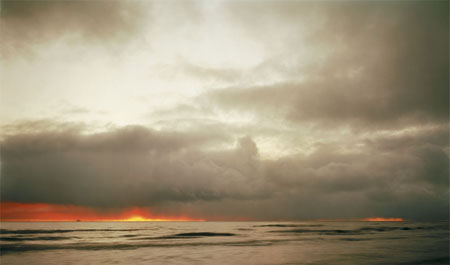When Tomorrow Is Today

TOWARDS TOMORROW (INTERNATIONAL DATE LINE, ALASKA), 2001
“Photography always refers to the past,” says Paris-born, London-based artist Marine Hugonnier. That is a default of the medium, and one that’s actually easy to forget. Capturing a moment for posterity is impossible, but film grabs at it in part.
For Huggonier, this inherent paradox of the medium drives her to manipulate it; she toys with the illusions humans impose upon time and space, and shatters comfortable misconceptions of the world around us. Her work—a cohesive mix of film, photography, and collage—has drawn praise for its creative examination of anthropological tensions, pitting socially-engineered constructs against a looming organic backdrops of seas, deserts, and skyscapes. Unlike, say, Hiroshi Sugimoto’s ocean photography, Hugonnier’s work does not signify nature as a tranquil muse. Rather, she focuses on making human civilization—and the systems it invents to define itself—feel incongruous with a planet that predates our species by millions of years. “I would rather talk about ‘landscape’ than nature,” she says. “Landscapes are designed. This is why I study how they are constructed: what are the systems of representation in place? It tells us a lot about ourselves.”
She challenged the International Dateline, and the imagined demarcations of past, present, and even future in “Towards Tomorrow,” a photography project exhibited last week at Art Basel as part of photography magazine Fantom and La Mer’s “The Sea Series”, alongside other marine-themed works by Ann Collier, Fabien Baron, Thomas Dozol, and John Waters. Shot only with an 8×10 camera, the idea of the project, she claims, was to “set up a trip only to create an image of the view across the International Date Line—and that image would be of the future.” The key was to shoot Siberia from the Bering Strait, territories physically separated by 53 miles but, chronologically, by 24 hours. That mission took Huggonier and two assistants embarking on an ill-timed trip to the Bering Strait in Alaska during the late summer of 2001, literally days before 9/11. “We were on the last stretch to get to Wales in Alaska when it happened,” she remembers. “As all flights were grounded, we set out on a tiny boat. The weather was freezing; the water was deadly cold.”
Indeed: the ostensible centerpiece of the nine-part Lambra print series is a formidable sea the color of ice. Shot over a period of a day, it remains a static glacial mirror, with only pernicious flares of orange sun indicating any time has passed. (“Sunrise or sunset—you choose,” she quips). It is a sobering, not particularly inviting portrait of the Alaskan/Siberian seascape. But, calendar-wise, it was proof that Huggonier had, indeed, captured the future—or at least forced it to confront the present. “It’s completely absurd,” she says, describing both the feeling of filming the future and the idea of time being something that can be systematically organized. “Suddenly, the past and future wanted to be one thing, at the same time.” Time had, in fact, collapsed—meaning Huggonier achieved her goal. And things only got stranger upon her return to the East Coast.
“On the way back to New York, we Fed-Exed all our negatives to escape the X-Ray machines,” she explains. “We were in Manhattan seven days after September 11, which was terrifying. I ended up making those images of the future, while the Twins Towers were falling and falling again on TV. It was as if the present was on a loop.”






